Join the AgriSolar Clearinghouse team for our webinar series with this round-table discussion featuring innovative solar designers Helical Solar, Sun Agri, Hyperion, Sandbox Solar, Solargik, RUTE Agrivoltaics, Soliculture, Stracker Solar, Taka Solar, and Sunstall!
Tag Archive for: Agrivoltaics
Minnesota energy companies, solar developers, farmers, and chefs are partnering in innovative ways to grow food, renewable energy, and pollinator habitat all within the same piece of land. The National Center for Appropriate Technology’s (NCAT) AgriSolar Clearinghouse today released its short film “Dive into the Prairie,” which takes viewers on a short tour of Minnesota’s agrivoltaic success stories.
AgriSolar or agrivoltaic partnerships are growing across solar-appropriate farmland in the U.S., providing a new revenue source for farmers, clean energy for surrounding communities, and myriad benefits to crops, livestock, and pollinators.
Chef Mateo Mackbee uses solar-grown foods at his St. Joseph, Minn., restaurant. Everything from salad greens grown under or around solar panels, to the honey that sweetens his salad dressing.
“Agrivoltaics is a big thing for me to see what can be grown, grazed, or raised in and around solar arrays,” said Chef Mackbee. “AgriSolar is the future, for sure.”
Mackbee sources solar-grown honey from Bare Honey, which partners with energy companies and solar developers to place his commercial beekeeping boxes on the same land as the solar panels and pollinator habitat.
“Pollination is a huge part of what commercial beekeeping is,” said Bare Honey founder Dustin Vanasse. “We have our co-located honeybees and those, combined with the native pollinators on these sites, will provide pollination to the farms that are around the site.”
NCAT’s AgriSolar Clearinghouse is connecting businesses, land managers, and researchers with trusted resources to support the growth of co-located solar and sustainable agriculture.
“The partnerships blossoming in Minnesota show a real-world example of how it can work for several industries that share common goals,” said NCAT Energy Director Stacie Peterson, PhD. “Land is finite, and AgriSolar partnerships mean we can maximize our resources for the benefit of communities, the environment, and businesses.”
Research Shows Crops Can Boost Photovoltaic Panel Performance and Longevity
“We now have, for the first time, a physics-based tool to estimate the costs and benefits of co-locating solar panels and commercial agriculture from the perspective of increased power conversion efficiency and solar-panel longevity,” said lead author Henry Williams, a doctoral student at Cornell.
“‘There is potential for agrivoltaic systems – where agriculture and solar panels coexist – to provide increased passive cooling through taller panel heights, more reflective ground cover and higher evapotranspiration rates compared to traditional solar farms,’ said senior author Max Zhang, professor in the Sibley School of Mechanical and Aerospace Engineering, ‘We can generate renewable electricity and conserve farmland through agrivoltaic systems.’” – News Wise
The study can be found here.
170 MW of Agrivoltaics to be Developed in Italy
“Enel Green Power has started building a 170 MW agrivoltaics plant in Viterbo, Italy. The Rome-based company claims it will be Italy’s largest agrivoltaics installation upon completion. The plant will feature bifacial PV modules mounted on trackers, both from undisclosed manufacturers.
Enel is using a ‘solar-first’ approach to solar and agriculture, with electricity generation remaining the main goal. Its approach is designed to retrofit large-scale solar plants to allow crops to grow between the trackers and the panels. Agriculture is integrated into existing solar farms, rather than the other way around, as is often the case in agrivoltaics projects.” – PV Magazine
Oregon Research Shows Agrisolar Benefits Crops and Livestock
“Putting solar panels on farmland, known as agrivoltaics, has been a bit of a political hot-potato in some parts of Europe and the U.S. For environmental engineer Chad Higgins, at Oregon State University, the choice between farmland and energy is a false one. There has to be thoughtful design, he says, but ’our research indicates they can coexist and even create mutual benefits.’
Researchers around the world are exploring growing everything from grapes and raspberries to potatoes and wheat under and between photovoltaic panels. Higgins has shown that sheep will preferentially graze in field areas where shade was offered by solar panels; lambs that foraged under solar panels put on as much weight as those in open fields and in late spring needed less water.” – Reuters

By Helge Biernath, Sunstall Inc.
I just attended the 2023 Solar Farm Summit, where I presented and spoke to the experts in the industry. One topic never came up: How will ESG (environmental, social, and governance) requirements from companies like Coca-Cola Now and Walmart influence agricultural photovoltaics? ESG requirements from such companies are likely to have a significant impact on agricultural photovoltaics (APV), the practice of integrating solar panels into agricultural lands.
Firstly, these companies have committed to reducing their carbon footprint and promoting sustainable practices in their operations, which will require them to procure renewable energy. APV is a form of renewable energy that can be integrated into agricultural production and help reduce the carbon footprint of these companies. Therefore, the ESG requirements of these companies may drive the adoption of APV by their suppliers and partners. And not only that: they will also require their suppliers to follow similar regimens to reduce the carbon footprint, and they will ask for strategic plans to get there and reports on the success.
Secondly, APV can offer several benefits to farmers, including providing an additional source of income, reducing water evaporation, and improving crop yield. By promoting the adoption of APV, these companies can encourage sustainable agricultural practices and support local communities. Given the ESG requirements, farmers will be asked to support the goal of carbon neutrality. It will be a challenge but also a huge opportunity through solar farming.

Finally, ESG requirements are increasingly becoming a factor in investment decisions, with investors looking for companies that prioritize sustainability and social responsibility. The adoption of APV can enhance the ESG profile of companies in the agriculture sector and help them attract more socially responsible investment.
In summary, the ESG requirements of companies like Coca-Cola and Walmart are likely to drive the adoption of APV in the agriculture sector, promoting sustainable practices, reducing carbon footprint, and improving the ESG profile of companies in the sector.
And the Oscar goes to THE FARMERS! They will be asked to help!
I feel with the solutions we have seen over the last days at the Solar Farm Summit, the agriculture and solar community is ready to support ESG goals.
All photos courtesy of Sunstall, Inc.
The National Center for Appropriate Technology’s (NCAT) AgriSolar Clearinghouse today premiered its short film “The Solar Shepherd” during the 2023 Solar Farm Summit in Chicago.
The film showcases a family-owned farm in central Massachusetts that’s raising sheep and solar energy on the same piece of land. AgriSolar or agrivoltaic partnerships are growing across solar-appropriate farmland in the U.S., providing a new revenue source for farmers, clean energy for surrounding communities, and myriad benefits to crops, livestock, and pollinators.
“It’s been a wonderful friendship between the two businesses,” says Solar Shepherd LLC founder Dan Finnegan. “We can’t access enough land to keep our farm sustainable, without this partnership with solar, we wouldn’t have a successful farm, we simply don’t have enough acres to graze.”
Finnegan partnered with SWEB Development Inc. on the 15-acre solar array which provides enough clean energy to power 1,100 homes and has so-far raised 45 lambs to maturity.
“You can have this partnership in a one-acre field, a 15-acre field up to a couple hundred acres,” says Joe Mendelsohn, project developer with SWEB Development Inc.
NCAT’s AgriSolar Clearinghouse is connecting businesses, land managers, and researchers with trusted resources to support the growth of co-located solar and sustainable agriculture.
“Tremendous potential exists in partnerships between farmers and solar developers,” says NCAT Energy Director Stacie Peterson, PhD. “As the demand for solar energy grows, it’s up to us to be good stewards of the finite land resources we have and maximize the benefit to farmers, communities, and the environment.”
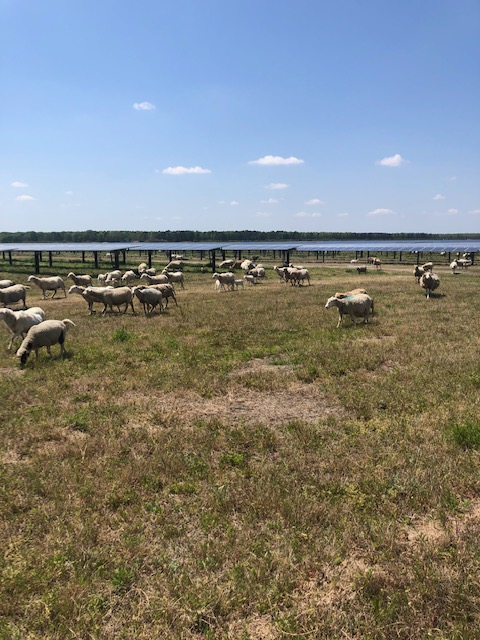
By Anna Richmond-Mueller, NCAT Energy Analyst
Located near Richmond, Virginia, the Mechanicsville solar park is one of the state’s first utility-scale solar sites. Covering over 220 acres, the 28-megawatt, single-axis tracking site provides a source of clean power to thousands of homes in the state. More than just a solar site, though, the location is also the home base for hundreds of sheep under the care of Eric Bronson and Sam Perkins at James River Grazing.
James River Grazing started in 2016 when founder Eric Bronson noticed the solar industry beginning to take off in Virginia. A Virginia native, Bronson attended college at Montana State University and worked for several years on large, range-based livestock operations before returning to his home state. He knew he wanted to stay involved in agriculture, but without already owning land, he realized the upfront costs were prohibitive. Compared to raising cattle or growing crops, the lower initial investment needed to successfully farm sheep gave Bronson the chance to farm in a traditional production environment before the company received its first solar grazing contract in 2019.
For solar sites without grazing plans, mowing must be brought in for vegetation management, a difficult task for many solar developers in recent years due to labor shortages. “The grazing came along at the perfect time,” Bronson says. He explains that the Mechanicsville site was being mowed about once a month, but with the integration of livestock, it was reduced to a “clean up” mow in the fall and smaller mows in early spring. Even then, “they’re not mowing one hundred percent of the site,” Bronson explains. Only about a quarter of the site is mowed at these times, significantly lowering the time and labor cost required to control the vegetation.
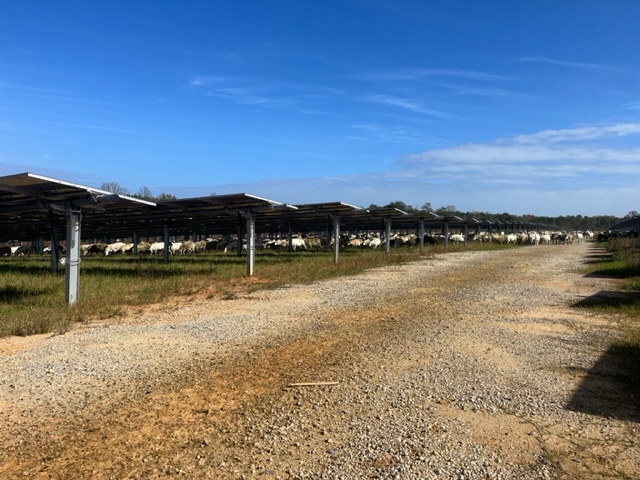
Operating on the Mechanicsville site didn’t come without its challenges, however. The site hosts between 100 and 300 ewes at a time, depending on the time of year and vegetation growth. While smaller operations will move flocks on and off location seasonally, James River Grazing operates on the site year-round. Not having facilities on-site and the expansive costs to move the sheep off-site is an added layer of difficulty that comes with grazing sheep on utility-scale sites. “Everything has to be portable,” Bronson points out. Nonetheless, James River Grazing’s efforts have been so successful that SunEnergy1, the solar developer for the site, hired Bronson as Director of Livestock for the entire company and has implemented solar grazing on a number of other sites, as well.
With a total of six grazing sites and around 1,500 sheep, Bronson says James River Grazing is looking to continue its success by creating additional partnerships with developers across the region. While being one of the first to embrace solar grazing comes with some advantages, it also means that learning involved a significant amount of trial and error. “That was one of the biggest roadblocks,” Bronson says, referring to the lack of available resources to help guide them in the early days. Their knowledge and experience also put them in an ideal place to help solar developers create construction plans with solar grazing in mind, making it much easier for grazers to care for the sheep on site. James River Grazing is still working out the details for exactly how they plan on moving into the consulting space, but their track record of success will undoubtedly make them a valuable resource for solar developers and new grazers alike.
All photos courtesy of James River Grazing.
NYPA Study Provides Best Practices for Agrivoltaic Systems
“The New York Power Authority (NYPA) announced the release of a new report, Agrivoltaic Leading Practices, that recommends proven and innovative approaches on integrating dual-land use for agriculture and solar energy production. The study determined that a best practice agrivoltaic site ideally involves stakeholder collaboration, community education, policy incentives, site safety practices, and site-individualized crop selection and solar-array design.
Researchers who authored the new report examined how native vegetation, pollinators, low maintenance plants, agricultural crops as well as grazing livestock can coexist on the same parcel of land as a solar energy project.” – The Mountain Eagle
Research Shows Crops and Solar Panels Benefit from Co-Existence
In the threatening trouble of climate change, growing commercial crops on solar farms is a potentially efficient use of agricultural land that can both increase commercial food production and improve solar panel performance and longevity, according to new Cornell research.
“’We now have, for the first time, a physics-based tool to estimate the costs and benefits of co-locating solar panels and commercial agriculture from the perspective of increased power conversion efficiency and solar-panel longevity,’ said lead author Henry Williams, a doctoral student in Cornell Engineering.” – Cornell Chronicle
New Solar Panels Harness Full Light Spectrum and Increase Crop Yields
“According to a new study from the University of California, the blue part of the light spectrum is the most efficient for solar energy production, while the red part is better for plant growth and crop yield. Now, scientists are investigating how harnessing the sun’s complete light spectrum can improve agrivoltaic system’s effectiveness in arid agricultural areas.” – Horti Daily
Commercial proprietary vertical racks cost more than all types of conventional PV farm racking solutions. To overcome these cost barriers, this study reports on the development
of a new wood-based PV racking design.
by Emily Griffith of Renewable NorthWest
Renewable Northwest and a small workgroup are preparing an update to the 2019 report, Dual-Use Solar in the Pacific Northwest: A Way Forward, in response to the changing landscape of agrivoltaics (also referred to as dual-use solar) in the region. This blog will explain the need for a fresh look at dual-use in the Pacific Northwest and describe some of the themes important to the conversation.
Why Do We Need to Revisit Dual-use Solar?
The Biden Administration recently set a goal of reaching 100% carbon-free electricity by 2035. Many states have similar requirements of reaching net-zero GHG emissions. To reach these targets, extensive buildout of solar energy will be a cornerstone of the evolving energy grid. Dual-use solar allows farmers to use their land both as farmland and as a site to generate electricity (and additional income).
In Renewable Northwest’s 2019 report, staff explored the potential and practicality of dual-use solar by looking at advantages and disadvantages, policies, project examples, and best practices. Given the increased attention agrivoltaics has received recently, including federal research investments and policy changes, it’s time to revisit the report. The updated report (to be completed in spring 2023) will explore recent updates in agrivoltaics. Here is what you can expect:
What Has Not Changed?
The conversation around dual-use in the Pacific Northwest is still in early stages. To date, the region still does not have many dual-use projects, but some solar and pollinator projects do exist. For example, Pine Gate Renewables’ Eagle Point Solar is a 13-MW solar and pollinator project located on 41 acres in Medford, Oregon. Previously, the land was used for dairy grazing. Now, the site contains a diverse seed mix of pollinating flowers with over 30 types of native flowers and grasses. Old Sol Apiaries is a business based in southern Oregon that provides bees for honey makers and commercial pollinators. Bees forage on native pollinator plants under Pine Gate’s panels. They also provide bees at other solar-pollinator locations, such as a 73-acre project in Clackamas County, Oregon.

There are a few reasons why dual-use is still not as widely used in this region as it is in others. For instance, there are still policy barriers. In fact, every year there are regular efforts pushing back against solar development by legislators in the Northwest. For example, in Oregon, the Land Conservation and Development Commission issued a rulemaking in 2019 limiting the amount of land to 12 acres that a farmer could use for a solar project located on high-value farmland. However, there was potential for counties to issue ordinances that could increase to 20 acres for dual-use projects. The difficulty with this rulemaking was that it sunsetted after two and a half years, and counties did not have much of a chance to develop an ordinance before the sunset. Additionally, counties in Washington state are continuing to develop ordinances that limit renewable energy development, including potential dual-use projects.
Agrivoltaics continues to be a challenging environment. The idea of agrivoltaics originated in Europe and is just gaining momentum in the U.S. A recent article by Jeff Turrentine at the National Resources Defense Council (NRDC) states that in a number of Asian and European countries, agrivoltaics has gained much more ground. For instance, in Japan, there are 2,000 agrivoltaic installations, whereas in the U.S., there are less than 50 accounted for. The U.S. is not as far along as others for a few reasons:
- There are significant up-front costs and barriers to entry.
- Research on large-scale solar with crops and grazing is still considered to be in early stages.
- There is limited transmission for projects to connect to. Projects most often need to be located near the electricity load (demand).
- Many farmers are still uneasy about the idea of combining solar and agriculture.
What Has Changed?
While there still are not many dual-use projects in the Northwest, we have seen more interest in the idea of advancing dual-use. New research continues to be published on the advances in dual-use technology and solar-crop compatibility. Some recent studies even suggest that, under the protection of solar panels, certain crops may grow stronger and longer that may otherwise succumb to higher temperatures more readily.
Another interesting Oregon State University study found that there is a symbiotic relationship between solar panels and the crops that grow beneath them. Crops exposed to increased levels of sunlight require more water. With solar panels providing shade and cooler temperatures, less water is lost to evaporation and the plants require less water from irrigation. But perhaps the more interesting finding is that the panels were found to perform better with the crops growing beneath them. The crops beneath the panels contributed to keeping the local environment cooler. With cooler temperatures, the panels operate more efficiently, generating about 10% more electricity than panels installed over gravel.
There are additional efforts and funding being devoted to studying and implementing dual-use projects. Last December, DOE announced $8 million in funding for projects that integrate solar energy production with farming. An energy.gov article states that the funding is intended to reduce barriers to both community and utility-scale solar energy deployment while also maximizing benefits to farmers and local communities. The six states (and the District of Columbia) selected for funding are not located in the Pacific Northwest region. However, the studies will likely produce valuable knowledge that can be integrated here, as well. Some of the topics pertain to socioeconomics, technical aspects, outreach strategies, deployment resources, sustainability, and markets in rural North America.
Additionally, in 2021, the USDA awarded the University of Illinois $10 million to determine the types of crops that are best suited to pair with solar. The research sites include Illinois, Arizona, and Colorado.
With already cost-competitive solar bolstered by the recent passage of the Inflation Reduction Act, solar development is expected to increase dramatically. Hopefully, this means we will see more dual-use projects. And, the increased interest in studying agrivoltaics from the DOE and USDA could perhaps be a sign federal aid is on the way for farmers interested in agrivoltaics. Right now, there is a real need for additional mechanisms and incentives for those interested in pursuing dual-use projects in particular.
How Is the Region Reacting to the Prospect of Dual-use?
While dual-use solar may not be a silverbullet solution to siting solar on farmland, it does offer a tool of flexibility for farmers. This tool can provide additional income that keeps farmers farming and keeps farmland as farmland. The previously mentioned NRDC article states that many people are optimistic about the idea of expanding agrivoltaic facilities with options to sustain farming, potential to bring in new farmers, and stabilize land for crops that could otherwise go to more permanent types of development.
What’s Next?
There are still many other areas of interest that updated report may investigate. For instance, we need to know: Four years later, where are we? Have many projects been implemented since 2019 and how are they doing? Are projects happening practically? What are the dos and don’ts of building a dual-use project? What are the many other studies saying? What are the farmers concerned about?
The U.S. is looking to develop about five times the solar we have to date over the next 10 years, and that solar will require land (at least for its useful life). But new solar buildouts don’t have to result in conflicts. Many think agrivoltaics is a key solution, especially when it comes to avoiding potential conflicts between energy and food production. And with more research and funding being devoted to the idea, dual-use is becoming less of a research question and more of a reality.
If you would like to be notified when the final and updated dual-use report is available, please contact Emily at emily@renewablenw.org
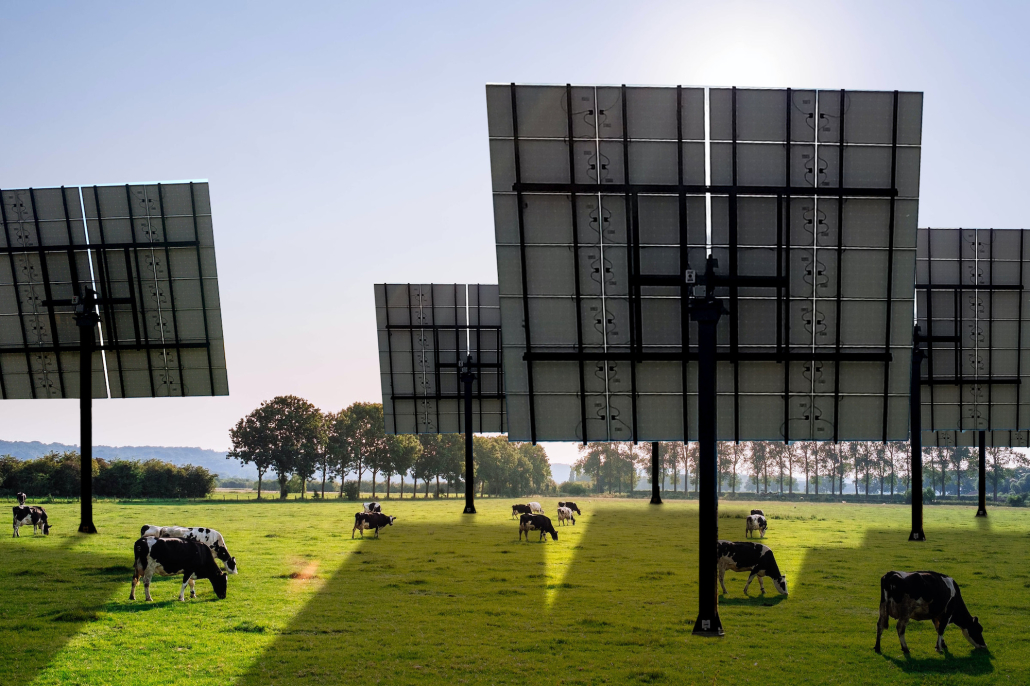
By Brigitta Banki and Kate Lundquist, Stracker Solar
Farmers and ranchers all over the United States are increasingly interested in taking part in solar energy initiatives. Agrivoltaics can mean not only cleaner energy, but also savings on operational expenses, as well as the opportunity to develop a secondary income stream by selling the power to utility companies or to offtakers directly through community solar programs.
The available options for agrisolar are greenhouse roof-mounted solar, fixed ground-mounted systems, and elevated solar trackers. Let’s look at the differences, pros, and cons of each type.
Greenhouse Roof-mounted Agrisolar
Fixed solar panels mounted on the roofs of greenhouses are generally the least efficient of all agrivoltaic solar solutions and come with limitations based on the location and roof direction of the structure. The ideal location for solar panels in the U.S. is facing south, with a secondary option of west-facing roof exposure.
In recent years, the popularity of greenhouse roof-mounted solar has grown since those buildings are generally built with a southern exposure. This option has the unexpected drawback of having a markedly negative impact on yields and energy output. One study from the University of Arizona found that when half the greenhouse roof was covered with conventional solar panels, crop output was reduced by 64% and panel productivity was 84% lower.
Fixed Ground-mounted Solar
Low ground-mounted solar panels are a slightly more efficient option. Available in different heights, the panels are installed on rows of metal racking: typical low ground-mounts are at 1 to 3 feet high, while high ground-mounts start around 6 to 7 feet high. A ground-mounted solar system has the advantage of relatively low installation costs, but the intricate support structure can greatly limit access and agricultural use of the land beneath and between the solar panels.
Only certain low-growing crops that are generally hand-cultivated and harvested (such as lettuce, chard, beets, spinach, and tomatoes) are easily grown beneath fixed solar arrays. Access for farm equipment, however, is reduced to the area between rows and only if the installation is designed accordingly. The space around and under a ground-mounted system can be used as grazing area for livestock, as well. However, grazing is only recommended for smaller animals like sheep and goats, in order to avoid damage to the panels or the supporting structure.
The advantages of fixed ground-mounted systems come from use with low-growing and shade benefitting crops. Benefits are particularly pronounced in regions with hot, dry climates like the American Southwest. Studies have shown that shading from solar panels can maintain and even increase crop yield while reducing water use, an especially welcome option for farms in the areas of the United States where drought is common and water rights are changing.
Elevated Solar Trackers
Elevated tracking solar is the newest and arguably most efficient solution for agrisolar due to the unique tracking design and elevated build. Dual-axis solar trackers have a drive core that moves the arrays along both east-west and north-south axes, maximizing the amount of time the panels receive direct sun exposure. Thanks to the ability to follow the sun’s exact location throughout the day, dual-axis solar trackers provide an increase in energy generation of 50% or more compared to fixed solar power systems with the same number and type of panels.
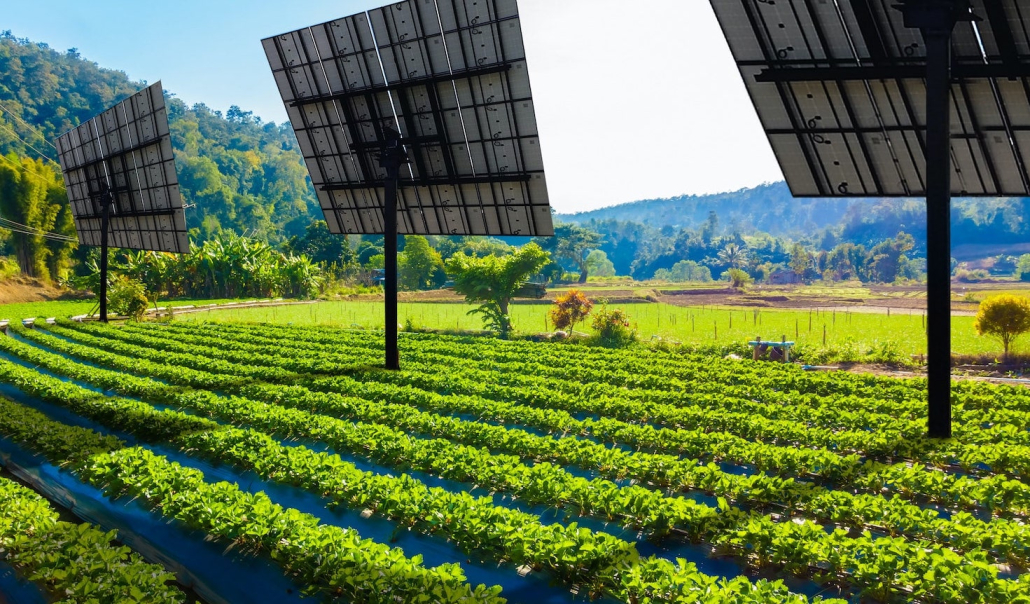
With maximized solar power production per panel, a small footprint, robust structure, and continued full use of the grounds, pole-mounted dual-axis solar trackers are also the most adaptable solar energy harvesting option for agrivoltaics. Single pole-elevated solar trackers, like Stracker Solar’s elevated dual-axis solar trackers, maintain full use of the land below the solar installation. These high-efficiency trackers feature a 13.6-foot minimum ground clearance with a mounting base of a mere 5 square feet, allowing easy access for every type of farm equipment. Furthermore, since it takes fewer of these high-efficiency solar trackers to generate the desired amount of energy compared to their fixed counterparts, a smaller area is sufficient for the solar installation. The Stracker elevated dual-axis solar trackers deliver up to 70% more energy production compared to fixed solar power systems of the same size. They provide access to solar energy generation while avoiding the financial drawbacks associated with compromising land use or crop yield.
Conclusion
Elevated solar trackers are ideal for agricultural use but all are not created equal. Given the current options for investing in agrisolar, pole-elevated dual-axis solar trackers provide the most flexibility and highest rates of energy generation currently available. These giant mechanical sunflowers maintain full use of the ground underneath the system by accommodating crops and livestock of all types and sizes, including wheat, corn, and cows. Large farm machinery for soil cultivation, crop harvesting, and processing can operate under the panels. Elevated solar trackers make installation on uneven, hilly, or difficult sites a possibility, as well.
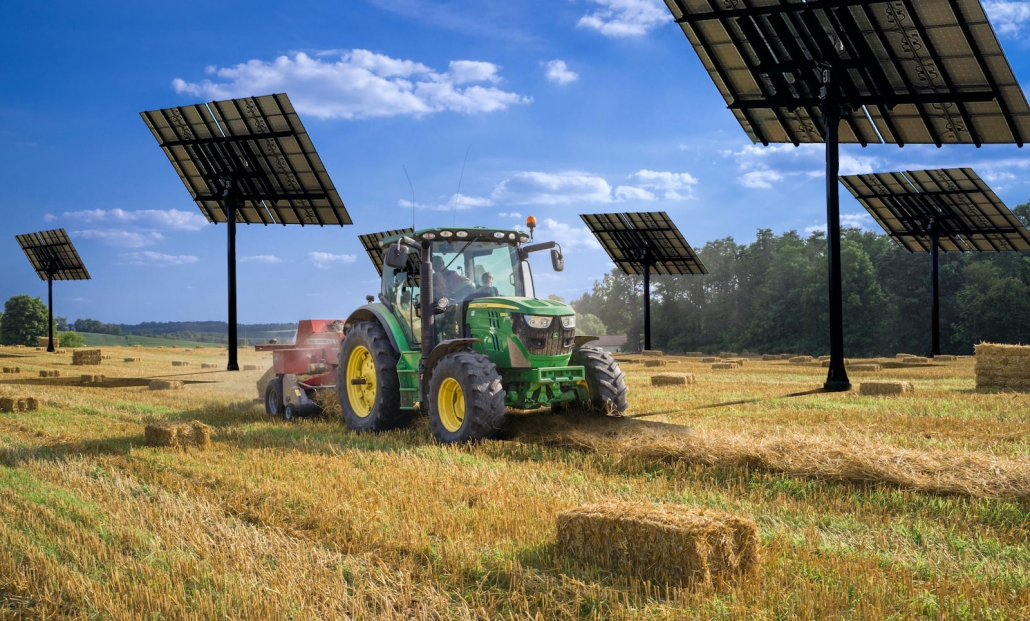
However, elevated dual-axis solar trackers vary greatly in design, materials, performance, and durability.
Some dual-axis solar trackers are built using cheaper, and less reliable, aluminum components to reduce costs, while others are built entirely of structural steel. The environmental conditions an installation needs to withstand for 30 or more years while maintaining optimum performance requires a high degree of stability and material strength, both of which are qualities of structural steel.
Material tolerance is another key aspect of solar tracking design that leaves no room for compromise. The build quality of solar trackers is determined by the way different parts of the drive core, as well as the bolts and plates are connected at each step of the way, down to the foundation. With loose connections and weak fittings that could be the result of weaker materials, a tracker could lose its ability to track accurately and perform safely over time.
The most complex, vulnerable, and expensive component of dual-axis solar trackers is the drive core mechanism. Some manufacturers use hydraulic motors and linear actuators, both of which can be the source of a variety of problems. A typical example is hydraulic tank leakage, which makes the tracker stop moving until replaced. These drive systems are often built of galvanized steel and aluminum, though they have plastic components as well, and they don’t meet the structural code requirements of many states. Slew drives are a more durable solution, yet fewer manufacturers use them because they are more expensive and require a higher level of precision to install. Stracker Solar’s elevated solar trackers are built entirely of structural steel and each unit uses two robust electrically driven slew drives for decades of strong performance.
High-quality materials, reliable design, and precision in assembly make a huge difference to the performance and durability of dual-axis solar trackers. But one cannot inspect all the screws and bolts before making a purchase decision. How can one have confidence that the chosen elevated solar tracker will work well in the long run?
That’s where structural warranty comes into the picture.
When calculating return on investment, one needs to consider the accompanying product warranty very carefully. The return on a system with a 10-year warranty is quite different from the return on a system with a 30-year warranty. Since after a 10-year warranty expires, farmers and ranchers will be responsible for the cost of troubleshooting and repairing any structural defects, which can significantly reduce their return over a longer period. Especially when we factor in that manufacturers who only offer a 10-year warranty are likely doing so because they know that their system failure rate beyond 10 years is too high. Stracker Solar is unique in offering a 30-year structural warranty on their elevated dual-axis solar trackers.
Researching available elevated dual-axis solar trackers and other applicable PV systems thoroughly and comparing key features, as well as considering power production data and costs, are very important steps before deciding on an agrivoltaic solution.
As the United States moves towards a zero-carbon future, farms and ranches have the opportunity to become primary sites for community and utility scale solar installations, increasingly supported by funds from the USDA. Elevated solar trackers provide an attractive option for agricultural operations looking towards solar to reduce operating expenses and/or establish a reliable secondary revenue stream.
All photos courtesy of Stracker Solar
